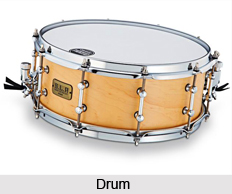 Drums belong to the family of the Percussion instruments. Such instruments with a drumhead are called membranophones. Drums, tambourine, timpani, bongo, and tabla are the referred to as membranophones. Amongst these the history of drums dates back to the birth of the civilisation itself. The first drum was discovered at the excavations of Mesopotamia and are said to belong to 3000 BC. In more or less every ancient culture, the drums played a significant part. Besides entertainment, this percussion instrument was often used for conveying messages and in religious ceremonies as well. Initially drums were played by hand or a stick. However, with passage of time it was discovered that one musician can play more that one drum at a time. Thus, the drum kit came into. Today in world music as well as Indian music, drums play a significant role. There are different types of drums that re used in musical compositions.
Drums belong to the family of the Percussion instruments. Such instruments with a drumhead are called membranophones. Drums, tambourine, timpani, bongo, and tabla are the referred to as membranophones. Amongst these the history of drums dates back to the birth of the civilisation itself. The first drum was discovered at the excavations of Mesopotamia and are said to belong to 3000 BC. In more or less every ancient culture, the drums played a significant part. Besides entertainment, this percussion instrument was often used for conveying messages and in religious ceremonies as well. Initially drums were played by hand or a stick. However, with passage of time it was discovered that one musician can play more that one drum at a time. Thus, the drum kit came into. Today in world music as well as Indian music, drums play a significant role. There are different types of drums that re used in musical compositions.
The Timpani or Kettledrum, for instance, is the most common type of drum to be found in the modern symphony orchestra. The Timbales, on the other hand, are closely related to the bongo in a number of respects. They are played exclusively in paired sets and the two drums are always at the same height, though they are not of equal size. The frame is usually made of copper or brass and trimmed with chrome or mother-of-pearl. Timbales are set on a stand so that the smaller of the two is to the player`s right. The instrument is played using thin, cylindrical drumsticks about 12 inches long, known as timbale sticks. The tone is changed by using different sticks. There is a special way of beating the drum called the "rim shot," in which the stick is allowed to hit the rim and the drumhead at the same time.
Another important drum is the Bass Drum. It can be found under a number of different names in the symphony orchestra. There is also the Snare Drum. It is an instrument encountered in the symphony orchestra, jazz, and the world of popular music. It belongs to the family of double-headed cylindrical drums. It is also called a "side-drum" or a "military drum." The snare drum has a cylinder-shaped frame, usually made of laminated wood or brass. The Tenor Drum, also known as the "beating drum", is somewhat larger than the snare drum. Its frame is usually made of ash or another type of wood. On the top and bottom, the drumhead is held taut by a framework attached to cords.
Another percussion instrument is the Tomtom. It is a drum like instrument that comes in different sizes. It originated in China and found its way into popular music in the 1920s. The smallest version is flat. The frame bulges outward slightly and is approximately 4 inches high with an eight-inch diameter. The frame is stretched with two drumheads which are immovably fixed. The Tomtom can be attached by a grommet to the bass drum of a jazz ensemble and is struck with a drumstick with a felt or leather head. The best-known version consists of a cylindrical frame of wood laminate. The instrument stands on three feet. Two strong pieces of buckskin are stretched on individual frameworks, with which they can each be independently tuned.
Slit Drums come in many shapes and sizes. What they all have in common is that they are made from a hollowed-out object, such as a piece of wood or bamboo. To hollow out the object, there has to be a starting point, and it is frequently a slit which is not closed up again after the work is completed. By making the outer wall of uneven thickness, different notes can be produced. There are slit drums with one or more slits, while X-shaped (Java) and H-shaped (Mexico) slits can also be found. The largest slit drums are found in Assam, India, whether they are assembled separately piece by piece in different buildings.
Apart from these drums, in the music world, Long Drums, Goblet Drums and Footed Drums, Barrel Drums, Hourglass Drums and Friction Drums are also used extensively.




















